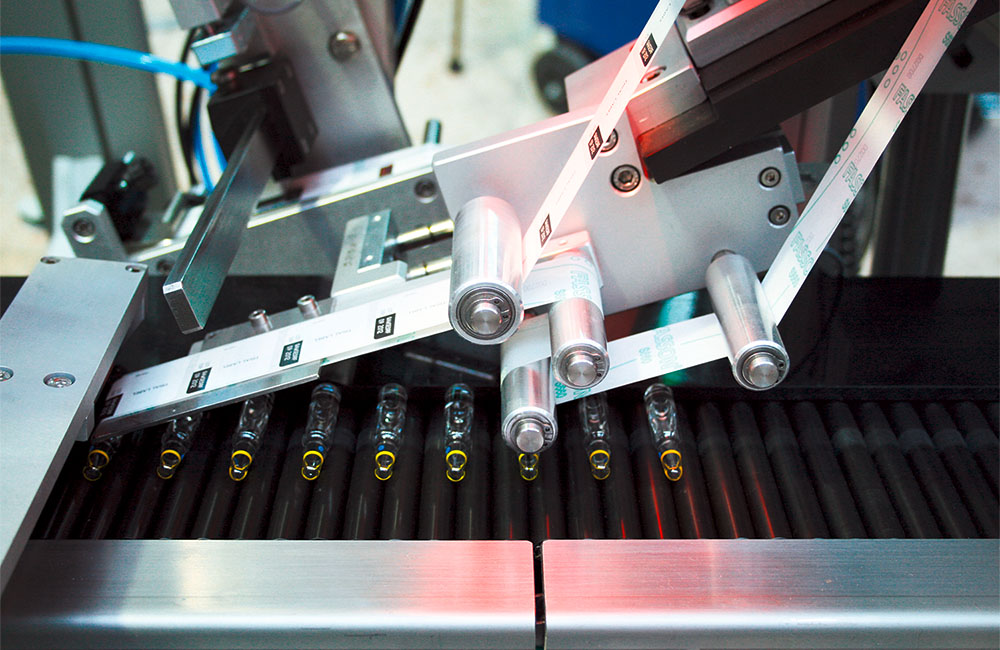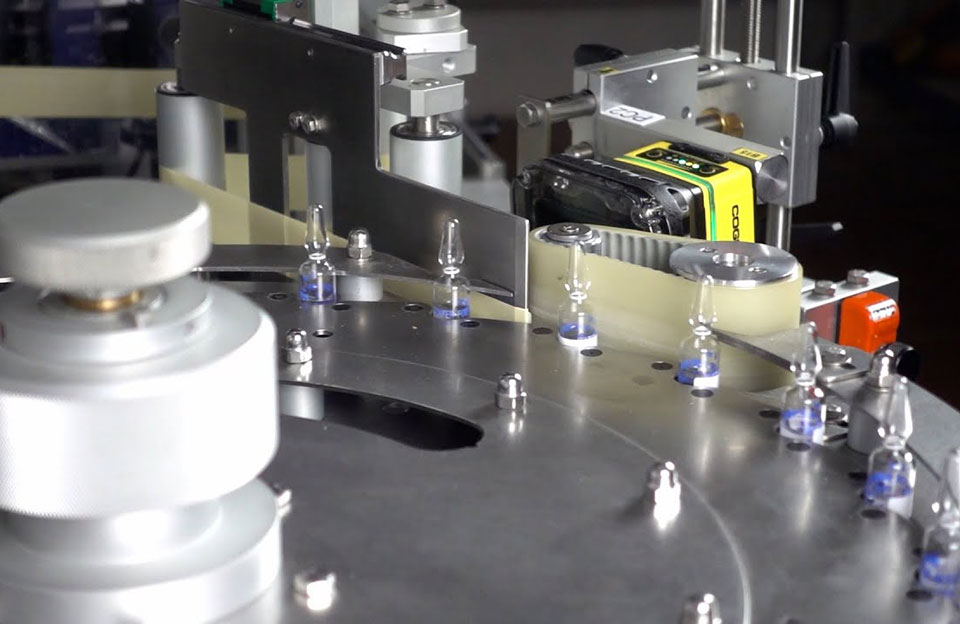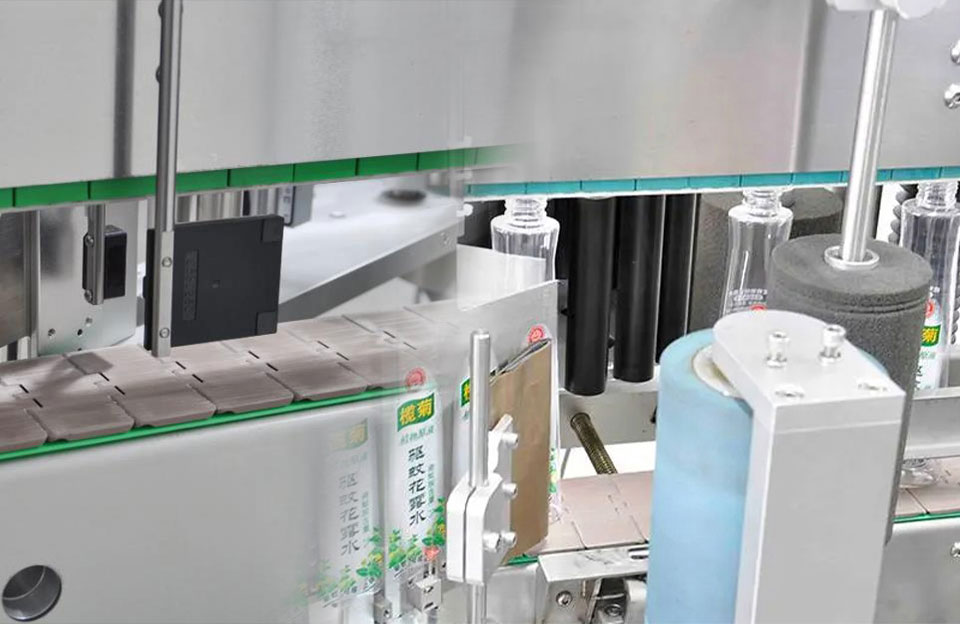In modern manufacturing, precise labeling is pivotal in various industries such as pharmaceuticals, food, chemicals, etc. Ampoule labeling machines have emerged as indispensable tools in ensuring accurate and efficient labeling of ampoule products. These machines offer high automation and accuracy, contributing significantly to product traceability, identification, and marketing strategies.
Basic Working Principle of Ampoule Labeling Machines
The basic working principle of ampoule labeling machines involves automated steps that ensure precise and consistent labeling of ampoule products. Here’s an overview of the process:
- Image Recognition and Analysis: The process begins with an imaging system that captures images of the incoming ampoules. This system uses cameras or sensors to analyze the ampoules’ shape, size, orientation, and specific features that distinguish one ampoule from another. This step is crucial for accurately positioning labels on each ampoule.
- Automated Positioning: Based on the image analysis, the labeling machine’s control system determines the optimal position and orientation for applying the label. It calculates the required adjustments to ensure the label is aligned perfectly with the designated area on the ampoule.
- Label Application: The machine uses a label dispenser or applicator to precisely place the label onto the predetermined position on the ampoule. This process is often carried out with the help of a conveyor belt or a rotating mechanism that ensures the ampoules are consistently presented to the label applicator.
- Label Adhesion: After the label is applied, mechanisms like rollers, brushes, or air pressure systems ensure the label adheres firmly to the ampoule’s surface. This step prevents issues such as peeling or misalignment during subsequent handling and transportation.
- Quality Inspection: Some advanced labeling machines have quality inspection mechanisms. These systems use additional sensors or cameras to verify the correct placement of the label. The machine may trigger an alert or reject the faulty ampoule if any discrepancies are detected.
- Ejection or Collection: Once the labeling process is complete, the labeled ampoules are either ejected onto a conveyor belt for further processing or collected in a designated container for packaging. This step depends on the specific production setup and the integration of the labeling machine with other equipment.
- Control and Feedback Loop: Throughout the process, the labeling machine’s control system monitors and adjusts various parameters to ensure consistent performance. It receives feedback from sensors and cameras, making real-time adjustments to maintain accuracy.
- User Interface and Settings: Operators can configure the labeling machine’s settings through a user-friendly interface. This includes specifying label dimensions, alignment tolerances, labeling speed, and other relevant parameters based on the ampoule specifications.

Ampoule Labeling Machines
Possible Challenges in the Development and Application of Ampoule Labeling Machines
The development and application of ampoule labeling machines can encounter several challenges that must be addressed to ensure successful implementation. Some of the potential challenges include:
- Ampoule Diversity: Ampoules come in various shapes, sizes, and materials. Designing a labeling machine that can accurately accommodate this diversity requires engineering solutions for seamless adjustment and positioning.
- Label Material Compatibility: Different label materials (paper, film, transparent, etc.) require specific handling mechanisms and adhesive properties. Developing a machine that can handle a range of label materials while maintaining adhesion quality can be complex.
- Label Placement Accuracy: Achieving high precision in label placement on ampoules is critical. Even slight misalignments can impact product aesthetics, regulatory compliance, and readability, which may lead to rejection or rework.
- Production Speed vs. Accuracy: Balancing the need for high-speed production with accurate label placement can be challenging. Increasing production speed might compromise the precision of label application, requiring sophisticated control systems.
- Vibration and Handling Challenges: In production environments, vibrations and handling variations can affect the consistency of ampoule presentation to the labeling machine. Ensuring label accuracy despite these external factors can be demanding.
- Quality Control and Rejection: Integrating quality control mechanisms within the labeling process, such as cameras and sensors, requires advanced image recognition and processing algorithms to detect and handle defects effectively.
- Integration with Production Lines: Seamlessly integrating ampoule labeling machines into existing production lines, including conveyors, robotic systems, and other machinery, necessitates compatibility and synchronization challenges.
- Changeover and Setup Times: Quick changeover times between different ampoule sizes or label types are crucial to minimize downtime and maximize production efficiency. Developing mechanisms that facilitate easy and rapid adjustments is important.
- Regulatory Compliance: Accurate labeling is essential for regulatory compliance in industries like pharmaceuticals. Developing labeling machines that meet these stringent requirements, such as serial number tracking, can be complex.
- Operator Training and Interface Complexity: Ensuring that operators can effectively use and maintain the labeling machine is important. Designing user-friendly interfaces and providing comprehensive training can help address this challenge.
- Maintenance and Reliability: Maintaining the labeling machine’s performance and reliability over time requires considerations for wear and tear, replacement parts availability, and preventive maintenance strategies.
- Cost and ROI: The development and integration of advanced features can drive up the initial cost of the machine. Balancing these costs with the potential return on investment, considering factors like increased production efficiency and reduced errors, is crucial.
- Sustainability: Addressing environmental concerns, such as reducing label waste and energy consumption, can be challenging while maintaining production efficiency and label quality.

Ampoule Bottle
Technical Characteristics and Innovations of Ampoule Labeling Machines
Ampoule labeling machines have evolved to incorporate various technical characteristics and innovations that enhance their efficiency, accuracy, and versatility. Some of these key characteristics and innovations include:
- Advanced Image Recognition: Modern ampoule labeling machines utilize advanced image recognition technology to analyze the shape, size, orientation, and unique features of each ampoule. This enables the machine to accurately determine the optimal label placement position.
- Multiple Positioning Systems: These machines often employ multiple positioning systems to accommodate different ampoule shapes and sizes. These systems can adjust the placement of ampoules based on their dimensions, ensuring consistent and precise label application.
- Automatic Label Adjustment: Ampoule labeling machines have mechanisms that automatically adjust label positions. This eliminates manual adjustments when changing ampoule sizes, thus improving operational efficiency.
- High-Speed Labeling: Many modern machines are designed to operate at high speeds, accommodating the demands of fast-paced production lines while maintaining accurate label placement.
- Precision Label Application: The labeling process involves precise label application techniques, such as pneumatic, vacuum, or mechanical applicators. These methods ensure that labels are affixed to ampoules with minimal chances of wrinkles, bubbles, or misalignment.
- Quality Inspection Systems: Some machines include built-in quality inspection systems that use sensors and cameras to verify label alignment and overall appearance. The machine can automatically reject or mark the faulty ampoules if any discrepancies are detected.
- User-Friendly Interfaces: Ampoule labeling machines often feature intuitive user interfaces that allow operators to easily input ampoule specifications, label dimensions, and positioning tolerances. This user-friendliness enhances setup and reduces the potential for errors.
- Data Logging and Reporting: Many machines offer data logging and reporting capabilities, recording information about labeled ampoules, rejected items, and production statistics. This data is valuable for quality control and process optimization.
- Integration with Automation Systems: Ampoule labeling machines can seamlessly integrate into larger automation systems, such as production lines or robotic handling systems. This integration optimizes overall production efficiency.
- Customization Options: Manufacturers often provide customization options to adapt the labeling machine to specific ampoule types, label sizes, and production requirements. This versatility ensures the machine’s suitability for various applications.
- Remote Monitoring and Control: Some machines offer remote monitoring and control capabilities, allowing operators to manage the machine’s performance, settings, and diagnostics from a centralized location.
- Energy Efficiency: Energy-efficient components and design considerations are increasingly integrated into modern labeling machines, contributing to sustainability efforts.
- Compatibility with Various Label Types: Ampoule labeling machines can accommodate different label materials, including paper, film, and specialty labels, expanding their range of applications.
- Predictive Maintenance: Some advanced machines incorporate predictive maintenance features that monitor the machine’s components and provide alerts or recommendations for maintenance before potential issues arise.

Ampoule Bottle
Conclusion
Ampoule labeling machines ensure accurate and efficient labeling across various industries. Their automation, precision, and contribution to product traceability underline their significance in modern manufacturing processes. These machines are poised to play an increasingly pivotal role in meeting labeling demands and industry requirements as technology advances.


